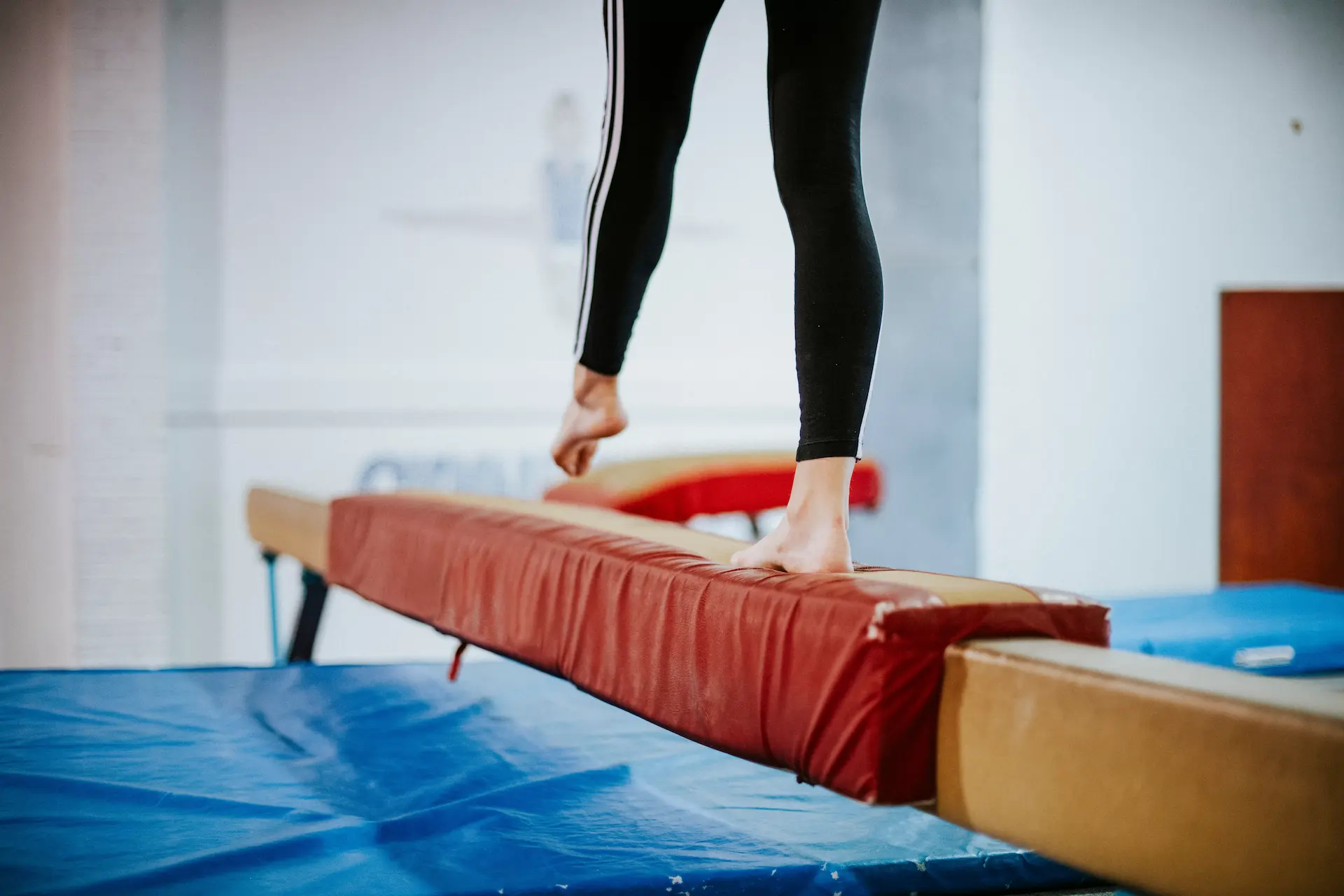Contents of Article
- Summary
- What is the Star Excursion Balance Test?
- Why is balance important in sports?
- How do you conduct the Star Excursion Balance Test?
- What is the Star Excursion Balance Test scoring system?
- Is the Star Excursion Balance Test valid and reliable?
- Further reading
- References
- About the Author
Summary
The Star Excursion Balance Test was developed to be a reliable measure of dynamic stability. Since then, it has proven to be a sensitive indicator of lower limb injury risk in a variety of populations. To add to this, the Star Excursion Balance Test has been shown to have high levels of intra-rater test-retest reliability, though no validity coefficients have been studied.
What is the Star Excursion Balance Test?
The Star Excursion Balance Test (SEBT) is a relatively simple, but somewhat time-intensive, test used to measure dynamic balance, otherwise known as dynamic postural control (1). It measures dynamic balance by challenging athletes to balance on one leg and reach as far as possible in eight different directions (2). Though the SEBT is very similar to the Y Balance TestTM, it is important to understand that these are in fact different, with the Y Balance TestTM being a newer and condensed version of the SEBT.
Performance on the SEBT has been shown to differentiate between individuals with lower limb conditions such as chronic ankle instability (3-10), patellofemoral pain (11), and anterior cruciate ligament reconstruction (12). To add to this, the SEBT is even capable of assessing improvements in dynamic balance following training interventions (13, 14).
Perhaps the SEBT’s greatest talent is its ability to identify athletes with a higher risk of lower limb injury. For example, an anterior reach asymmetry of greater than 4cm during the SEBT has been suggested to predict which individuals are at higher risk of lower limb injury (15). However, other researchers have found that only female athletes with a composite score of less than 94 % of limb length were at greater risk of injury (15). More recent research in collegiate American football players has shown that athletes with a composite score of less than 90 % are 3.5 times more likely to sustain an injury (16).
All of this information suggests that each sport and population (e.g. gender) appear to have their own injury risk cut-off point (15, 16).
Why is balance important in sports?
Balance, otherwise known as ‘postural control’, can be defined statically as the ability to maintain a base of support with minimal movement, and dynamically as the ability to perform a task while maintaining a stable position (17, 18). In a chaotic sporting environment, the ability to maintain a stable position is vital not only for successful application of the skill but to also reduce the likelihood of injury (15, 16, 19).
As dynamic balance is an integral part of performance, and poor balance is related to a higher risk of injury (20, 21, 15), then it may be of great interest to test and monitor an athlete’s dynamic stability.
How do you conduct the Star Excursion Balance Test?
It is important to understand that whenever fitness testing is performed, it must be done so in a consistent environment (e.g. facility) so it is protected from varying weather types, and with a dependable surface that is not affected by wet or slippery conditions. If the environment is not consistent, the reliability of repeated tests at later dates can be substantially hindered and result in worthless data.
Required Equipment
Before the start of the test, it is important to ensure you have the following items:
- Reliable and consistent testing facility (minimum 2×2 metres (m)).
- Test administrator(s)
- Sticky tape (minimum 8m)
- Measuring tape
- Performance recording sheet
Test Configuration
Video 1 displays the test configuration for the SEBT. This setup must be adhered to if accurate and reliable data is desired. The test administrator should stick four 120 cm lengths of sticky tape onto the floor, intersecting in the middle, and with the lines placed at 45° angles (2).
Procedure:
Warm-up
Participants should thoroughly warm up prior to the commencement of the test. Warm-ups should correspond to the biomechanical and physiological nature of the test. In addition, sufficient recovery (e.g. 3-5 minutes) should be administered following the warm-up and prior to the commencement of the test.
Conducting the test
- The athlete should be wearing lightweight clothing and remove their footwear. After doing so, they are then required to stand in the centre of the star and await further instruction.
- When using the right foot as the reaching foot, and the left leg to balance, the athlete should complete the circuit in a clockwise fashion. When balancing on the right leg, the athlete should perform the circuit in an anti-clockwise fashion.
- With their hands firmly placed on their hips, the athlete should then be instructed to reach with one foot as far as possible and lightly touch the line before returning back to the starting upright position.
- With a pencil, the test administrator should mark the spot at which the athlete touched the line with their toe. This can then be measured from the centre spot after the test to calculate the reach distance of each reach direction. Reach distances should be recorded to the nearest 0.5cm (22).
- They should then repeat this with the same foot for all reach directions before changing foot.
- After they have completed a full circuit (every reach direction) with each foot, they should then repeat this process for a total of three times per leg. For example, they should have three anterior reach performances for both their right and left leg.
- Once the athlete has performed three successful reaches with each foot in all directions, they are then permitted to step away from the testing area.
- The test administrator should have recorded the reach distance of each successful attempt, with a pencil, in order to calculate the athlete’s SEBT score after the test.
NOTE: Failed attempts include the following:
- The athlete cannot touch their foot down on the floor before returning back to the starting position. Any loss of balance will result in a failed attempt.
- The athlete cannot hold onto any implement to aid their balance.
- The athlete must keep their hands on their hips at all times throughout the test.
- The athlete must lightly touch their toe on the reach line whilst staying in full control of their body. Any loss of balance resulting in a heavy toe/foot contact with the floor should be regarded as a failed attempt.
What is the Star Excursion Balance Test scoring system?
With the test complete and all performances measured and recorded, the test administrator can then calculate the athlete’s SEBT performance scores using the following simple equations (17):
- Average distance in each direction (cm) = Reach 1 + Reach 2 + Reach 3 / 3
- Relative (normalised) distance in each direction (%) = Average distance in each direction / leg length * 100
These calculations should be performed for both the right and left leg in each direction, providing you with a total of 16 scores per athlete.
Is the Star Excursion Balance Test valid and reliable?
Though no validity coefficients are available for the SEBT, authors (23) have provided evidence that the SEBT is sensitive for screening various musculoskeletal injuries (17). Furthermore, high intratester reliability has been found for the SEBT (intraclass correlation coefficients = 0.78 – 0.96) (24).
Further reading
We suggest you now check out this article on The Landing Error Scoring System (LESS).
Disclaimer
All information provided in this article is for informational and educational purposes only. We do not accept any responsibility for the administration or provision of any testing conducted, whether that results in any positive or negative consequences. As an example, we do not take any responsibility for any injury or illness caused during any test administration. All information is provided on an as-is basis.
- Nelson, Brian D., “Using the Star Excursion Balance test as a predictor of lower extremity injury among high school basketball athletes” (2012).Theses and Dissertations. Paper 389. [Link]
- Gribble PA, Kelly SE, Refshauge KM, Hiller CE. Interrater Reliability of the Star Excursion Balance Test. Journal of Athletic Training 2013;48(5):621–626. [PubMed]
- Akbari M, Karimi H, Farahini H, Faghihzadeh S. Balance problems after unilateral lateral ankle sprains. J Rehabil Res Dev. 2006;43(7): 819–824. [PubMed]
- Gribble PA, Hertel J, Denegar CR. Chronic ankle instability and fatigue create proximal joint alterations during performance of the Star Excursion Balance Test. Int J Sports Med. 2007;28(3):236–242. [PubMed]
- Gribble PA, Hertel J, Denegar CR, Buckley WE. The effects of fatigue and chronic ankle instability on dynamic postural control. J Athl Train. 2004;39(4):321–329. [PubMed]
- Hale SA, Hertel J, Olmsted-Kramer LC. The effect of a 4-week comprehensive rehabilitation program on postural control and lower extremity function in individuals with chronic ankle instability. J Orthop Sport Phys Ther. 2007;37(6):303–311. [PubMed]
- Hertel J, Braham RA, Hale SA, Olmsted-Kramer LC. Simplifying the Star Excursion Balance Test: analyses of subjects with and without chronic ankle instability. J Orthop Sport Phys Ther. 2006;36(3):131– 137. [PubMed]
- Martinez-Ramirez A, Lecumberri P, Gomez M, Izquierdo M. Wavelet analysis based on time-frequency information discriminate chronic ankle instability. Clin Biomech (Bristol, Avon). 2010;25(3): 256–264. [PubMed]
- Nakagawa L, Hoffman M. Performance in static, dynamic, and clinical tests of postural control in individuals with recurrent ankle sprains. J Sport Rehabil. 2004;13(3):255–268. [Link]
- Olmsted LC, Carcia CR, Hertel J, Shultz SJ. Efficacy of the Star Excursion Balance Tests in detecting reach deficits in subjects with chronic ankle instability. J Athl Train. 2002;37(4):501–506. [PubMed]
- Aminaka N, Gribble PA. Patellar taping, patellofemoral pain syndrome, lower extremity kinematics, and dynamic postural control. J Athl Train. 2008;43(1):21–28. [PubMed]
- Herrington L, Hatcher J, Hatcher A, McNicholas M. A comparison of Star Excursion Balance Test reach distances between ACL deficient patients and asymptomatic controls. Knee. 2009;16(2):149–152. [PubMed]
- McKeon PO, Ingersoll CD, Kerrigan DC, Saliba E, Bennett BC, Hertel J. Balance training improves function and postural control in those with chronic ankle instability. Med Sci Sports Exerc. 2008; 40(10):1810–1819. [PubMed]
- McLeod TC, Armstrong T, Miller M, Sauers JL. Balance improvements in female high school basketball players after a 6- week neuromuscular-training program. J Sport Rehabil. 2009;18(4): 465–481. [PubMed]
- Plisky PJ, Rauh MJ, Kaminski TW, Underwood FB. Star Excursion Balance Test as a predictor of lower extremity injury in high school basketball players. J Orthop Sports Phys Ther. 2006;36(12):911–919. [PubMed]
- Butler RJ, Lehr ME, Fink ML, Kiesel KB, Plisky PJ. Dynamic balance performance and noncontact lower extremity injury in college football players: an initial study. Sports Health. 2013;5(5): 417–422. [PubMed]
- Bressel E, Yonker JC, Kras J, Heath EM. Comparison of Static and Dynamic Balance in Female Collegiate Soccer, Basketball, and Gymnastics Athletes. Journal of Athletic Training 2007;42(1):42–46. [PubMed]
- Winter DA, Patla AE, Frank JS. Assessment of balance control in humans. Med Prog Technol. 1990;16:31–51. [PubMed]
- Zazulak B, Cholewicki J, and Reeves NP. Neuromuscular control of trunk stability: Clinical implications for sports injury prevention. J Am Acad Orthop Surg 16: 497–505, 2008. [PubMed]
- de Noronha M, Franca LC, Haupenthal A, Nunes GS. Intrinsic predictive factors for ankle sprain in active university students: a prospective study [published online January 20, 2012]. Scan J Med Sci Sports. doi:10.1111/j.1600-0838.2011.01434. [PubMed]
- McGuine T. Sports injuries in high school athletes: a review of injury-risk and injury-prevention research. Clin J Sports Med. 2006;16:488-499. [PubMed]
- Shaffer SW, Teyhen DS, Lorenson CL, Warren RL, Koreerat CM, Straseske CA, Childs JD. Y-Balance Test: a reliability study involving multiple raters. Mil Med. 2013;178(11):1264-70. [PubMed]
- Olmstead L, Carcia C, Hertel J, Shultz S. Efficacy of star excursion balance test in detecting reach deficits in subjects with chronic ankle instability. Journal of Athletic Training. 2002;37(4):501-507. [PubMed]
- Hertel J, Miller S, Denegar C. Intratester and intertester reliability during the star excursion balance test. Journal of Sport Rehabilitation. 2000;9(1):104-116. [Link]




